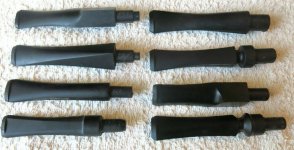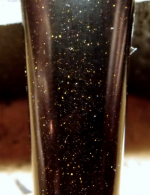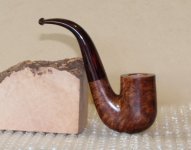View attachment 105786
Most stems on most pipes are "cast" I suppose, injection molded vulcanite. They come in every shape and size you can imagine (in fact in this picture you can see the designation number on some of the tenons.
This is what probably 99% of the pipes ever made got. That includes every Wilmer, Kaywoodie, Grabow (who now use ABS instead of vulcanite I'm told), every basket pipe in every shop that you've ever seen.
These get sanded heavily and polished up and look... just like a pipe stem.
In fact,
@Briar Lee you had shown us a picture of some Lee pipes, stem on, and one of them, a higher grade one, had a lot more handwork done to it - you can tell it's the same basic stem but a lot more time went in.
This tradition comes from the French factories, some of which cast their own blanks, simply called "vulcanites" in the trade. Some higher end pipes got fully handmade (obviously with machines, but a stem made from a rod, not cast as a blank) stems. Dunhill stems are all cut, and the vulcanite is almost always better in those rods than the blanks in terms of not going grey/green with use. There are exceptions - old Master Craft pipes have stems that are obviously vulcanite, but it's a very impervious sort, and I don't know the chemical composition enough to say why. Savinelli offers the opposite - their vulcanite is super soft, goes grey in one smoke for me... it's terrible. I am told sulfur content is key, but I really don't know. I let the ebonite guys make ebonite, and I buy it.
Cutting a stem takes all kinds of time and skill, and so you just never, ever see a cut vulcanite (rod form called "ebonite") stem on an inexpensive pipe. If you buy an 80 dollar Peterson with a vulcanite stem, it's not as good a material as the rod-stock cut stem on a 300 dollar one.
Being cut from rod doesn't guarantee a stem is good - being cut from rod by someone who knows what they are about does though, and I've never known cast stem as smooth inside as the best cut stems, and that's where the rubber hits the road, as it were. Those old Barlings and Sasienis are like glass inside the stem. No rough transitions.
There are good cast stems, both in terms of function and durability, and there are bad ones. I don't know how to tell them apart except to use a pipe and see what happens. I hate vulcanite, almost all the pipes I use are acrylic.









